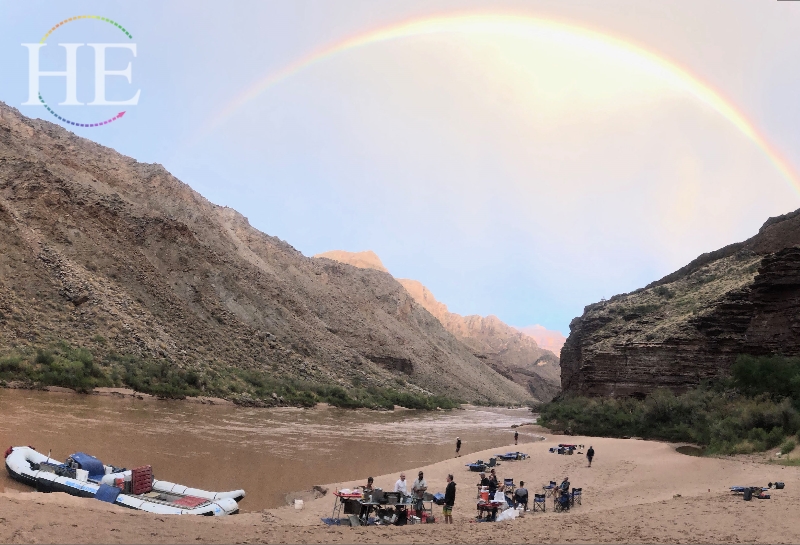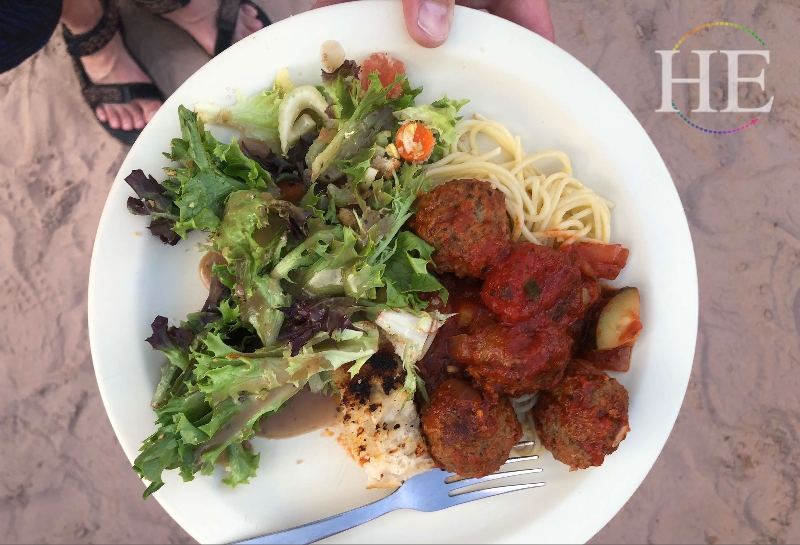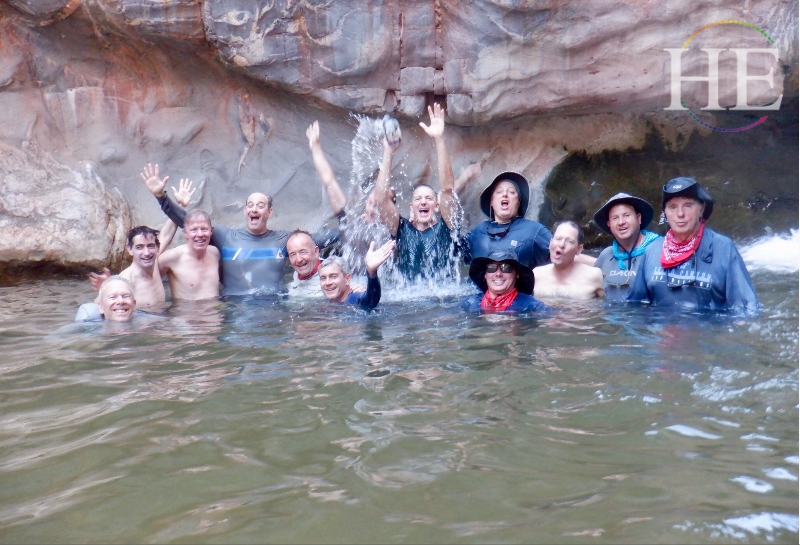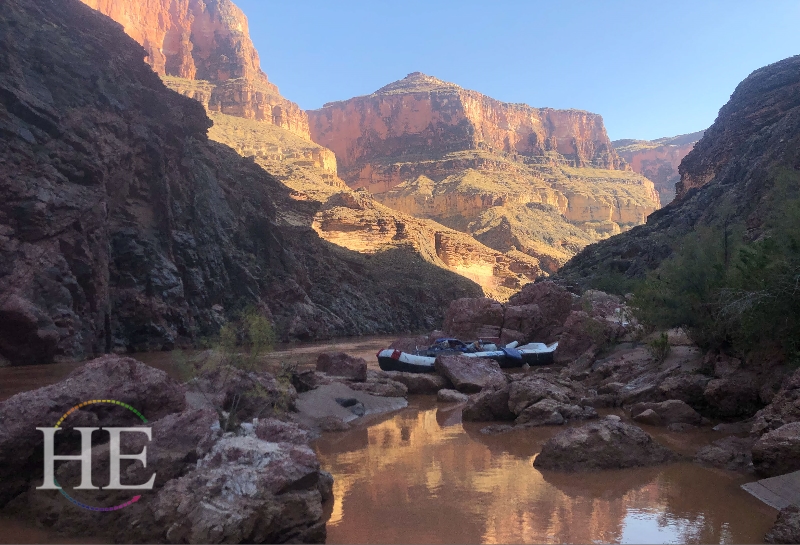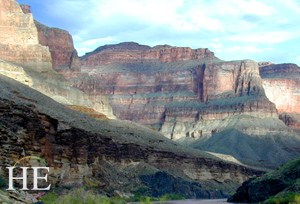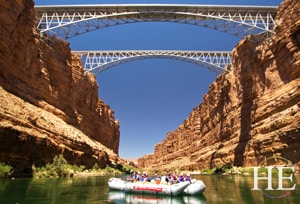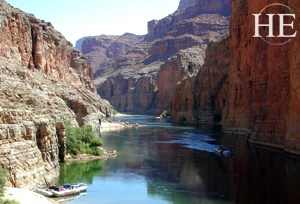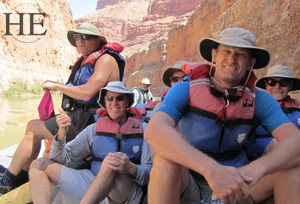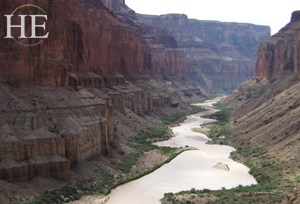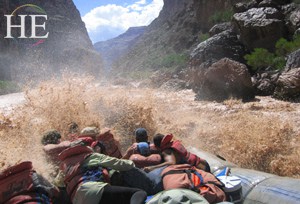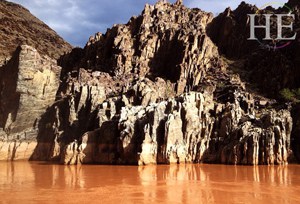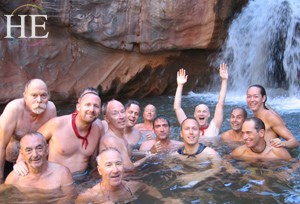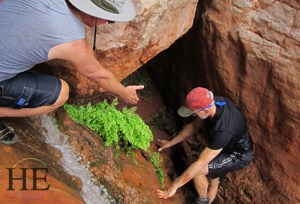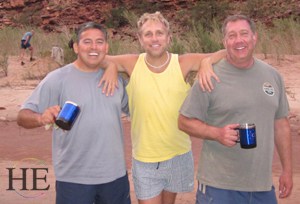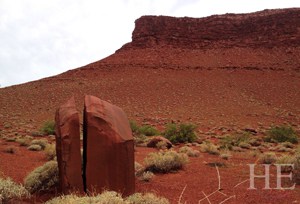Splash! Gay Grand Canyon Rafting Adventure
A Gay Grand Canyon Rafting Adventure on the Colorado River
Prices listed are per person:
Shared Room: $5398
Private Room: $5698
Prices listed are per person:
Shared Room: $5398
Private Room: $5698
Marvel at the breathtaking grandeur and vistas of the Grand Canyon, ride thrilling whitewater roller coasters, hike remote canyons to cascading waterfalls, and take time for self-reflection in profound quiet, while the Colorado River whispers you to sleep each night.
Our Gay Travel Blog has personal stories from our guides: Zach, Sara, Trisha, Darin and Jim.
Highlights
Plunge through whitewater rapids with such colorful names as Soap Creek and Lava Falls, on a 14-person motorized raft. No paddling necessary!
Enjoy gourmet meals provided by one of the Canyon’s top outfitters.
Cool off in cascading waterfalls.
Hike to the extraordinarily beautiful ruins at Nankoweap.
Find yourself by hiking up towering side canyons rarely seen by most visitors to the Park.
Overview
White water, red rock, blue sky:
Rafting through two billion years of history
No geologic feature in America inspires the imagination as does the Grand Canyon. A mile deep, up to eighteen miles wide, and slashing through 2 billion years of rock, the Canyon is viewed from above by millions of visitors each year — but far fewer travel into its depths.
Our rafting trip carries us down the entire 280 miles of the Colorado River in Grand Canyon National Park, through a hundred whitewater rapids, with a motor to keep us moving so we can relax and enjoy the changing spectacle above us. By day, when we’re not rafting through the Grand Canyon we’ll explore hidden side canyons, hiking among rock sculptures of every color — black, red, blue, and white — and enjoy numerous waterfalls and swimming holes. In the evening, socialize over a tasty dinner as you get to know your new friends in our small group — just 14 of us, plus two guides. By night, sleep under a canopy of stars, as the river continues its journey of the ages.
Itinerary
Map:
For our week of Grand Canyon white-water rafting, we use an outfitter with a long history of safe trips down the Colorado River. The description below recounts one particular recent Splash! trip. This departure was designated specifically as a gay men’s trip; except for that, the description below is a good, general description of what you can expect. Some specific stops, hiking routes, and other details may change, based on weather, time of year, and other conditions.
Day 1: Arrival
Our week begins in Las Vegas, a short distance for crows, but a long way, culturally and aesthetically, from the Grand Canyon. It’s still a good launching point: Flights to Las Vegas are frequent, and generally inexpensive, from most North American cities.
At 6:00 p.m. our group meets for a reception and light dinner It’s a great opportunity to get the know the others with whom we’ll be spending the week. There are 14 on our raft, plus two guides. We have ten states represented among us. There are two couples; everyone else came by themselves.
Our reception is followed by an orientation by the outfitter, with time to review common questions about what to expect and what to bring along. Everyone gets a waterproof bag for clothing and similar items, plus a small “waterproof” box for items such as cameras. It doesn’t seem like a lot of space, but the rafting outfitters emphasize how little you actually need, in the bottom of the Grand Canyon. Sure enough, at the end of the week, a frequent comment in our group is that “I never touched half the stuff at the bottom of my bag.”
A few in our group have the energy for a Las Vegas show. Most of us pack, get our alarms set for our early departure, and head for bed.
Day 2: Onto The Rafts
An early-morning bus is waiting to take us to Lees Ferry, the last spot with easy road access to the Grand Canyon. On the way, we pick up our sleeping bags and pads, already packed in their own watertight bags, and our two guides join the group.
Our senior guide is Cleve, a river runner for half his still-young life. Even now, embarking on his 102nd trip, Cleve’s love of the Colorado River, of the Grand Canyon, of white water, and of people, quickly becomes evident.
Assisting Cleve, in a position colloquially known as the Swamper, is Jason. He is a college student and occasional rodeo rider.
“How will the guides feel about being with a bunch of gay people?” is a common concern for members of our group, who conjure up the worst stereotypes of the Old West. It’s soon clear that we have no worries in this department. Both guides are comfortable with themselves, and with us, and gay issues promptly become a non-issue.
Well before lunch, we’ve reached the Colorado River, boarded the raft, luggage and bedrolls are strapped down, and we get underway. Immediately we’re greeted by one of the canyon’s denizens, a Great Blue Heron returning to the nest after a fishing expedition.
The first major whitewater comes at mile 8: Badger Creek Rapids. Well in advance, Cleve introduces us to the “Rapid Positions” we should take whenever we reach whitewater. Those in front sit in three rows of three, facing forward, tucked between one another’s legs. The front riders will get the most excitement, the greatest bouncing, and the heaviest spray. In the whitest of the white water, they’ll need to hold tight to the straps.
The center section of the raft, known as the Tea Room (they named this spot before we arrived, honest!) offers a somewhat smoother and drier ride — but only somewhat. As we splash through Badger Creek Rapids, even those in the center feel as if they’re on a bucking bronco.
Cleve is not only experienced at white-water rafting but also knowledgeable about the Colorado River’s geology and history. He points out a layer of Coconino sandstone, one of some 20 distinct and different rock layers exposed along the walls of the Grand Canyon, and one of the most important. Harder than many of the shales and conglomerates that form other layers, and that leaves a slope where the river cuts through them, the Coconino Sandstone erodes away into vertical cliffs. It also protects the layers below it from erosion, creating steep canyon walls. Without it, the Grand Canyon would lose much of its drama.
In the afternoon, we pull onto a sandy beach and set up camp for the night. There’s no shortage of spots on which to spread your sleeping bag: Select a riverfront site to be cooler; or a sandy patch back in the rocks, for more privacy.
Day 3: An Anasazi Relic
A hot breakfast of scrambled eggs, bacon, fresh pineapple and melon, and coffee — and we’re off. Within 2 miles, we’ve entered the section of the Colorado River known as the Roaring Twenties, with rapids at the 21, 22, 23, 24, 25, 26, and 27-mile points. None of the waves or drops are especially big, but cumulatively, they offer a good wake-up run.
At a spot known as the South Canyon, we pull off for a short hike to Anasazi Indian ruins. The Anasazi (also known as the Hisatsinom) appeared in the American Southwest about 2000 years ago. The 220-room Cliff Palace at Mesa Verde National Park is the best-known Anasazi ruin, but here at the base of the Grand Canyon we also find the crumbled foundations of their simple stone buildings.
Pottery shards 700 years old still show up here, and Cleve’s sharp eyes identify one. We each examine it, awed by its survival abilities, then Cleve returns it to the spot where it was found. This is a National Park, nothing may be removed, and next week’s rafters will be equally intrigued by this remnant of the past. We’ll see more evidence of the Anasazi as we continue our journey.
Next stop: Redwall Cavern, a sprawling horizontal gash carved from a softer layer of rock by the untiring river. Would-be rock climbers can practice a sequence on the roof in the back of the cavern, while others evaluate the report of John Wesley Powell, who estimated the chamber could hold 50,000 people.
At mile 40, we pass a troubling reminder of human arrogance: Rock tailings and several large drill holes mark the site of the proposed Marble Canyon Dam, a massive project begun in the 1960s that would have destroyed the Grand Canyon as we know it. Today, such a project would (we hope) be unthinkable. In the sixties, the dam was stopped only due to massive protests orchestrated by the Sierra Club.
We wash up in the river, then enjoy another tasty dinner. Cleve’s talents extend even to the camp kitchen. On the menu, tonight is halibut steak with herbed sour cream sauce, black beans and rice, and slaw. And for dessert, a birthday cake, freshly baked in the dutch oven.
Day 4: Sipapu: The Big Navel
Today’s breakfast: Blueberry pancakes with hot syrup, sausage, fresh fruit, and coffee or tea. It continues to amaze us what can roll off the camp stove!
Just a few miles downstream at Nankoweap Canyon, lies a larger Anasazi / Hisatsinom ruin. High in the cliffs, sheltered overhead by a ledge of sunburnt sandstone, four dark rectangles are just visible from the river.
These are the openings of an Anasazi granary. High as they seem, a 30-minute hike, zig-zagging up the cliffs, takes us to the ancient structures. The Anasazi walled off four storage chambers to protect their grain from rodents. Each chamber was filled, then sealed off until needed. Sitting on the edge of a structure that was built centuries before the first Europeans reached America, we get a new sense of the Grand Canyon’s history.
Except — we’re not yet officially in the Grand Canyon. Colloquially, everyone refers to the Grand Canyon as the chasm that starts at Lees Ferry. But technically, the first 61 miles are known as Marble Canyon, a name given by Powell. (The rock is actually limestone, not marble; Powell seems to have used the term marble metaphorically, to suggest the grandeur of the space.) The “Grand Canyon” designation doesn’t officially apply until the Little Colorado River joins in.
For us, the Little Colorado is memorable for a different reason: It’s a big playground where the water of surreal blue tint has carved natural slides between the white boulders. Cleve and Jason show us how to reposition the lifejackets around our waists, and for nearly two hours, we whoosh down the river, singly, then in chains.
The blue waters of the Little Colorado come from a spot that the Anasazi called Sipapu, — the big navel, and the source of life.
Today’s biggest rapid is Unkar, where the water level drops 25 feet. (These “drops” — and let’s be clear about this — do not happen all at once. A 25-foot-drop is not a 25-foot waterfall, or we’d have all gotten out and walked. It means the water level drops 25 feet within the stretch of rapids. Here at Unkar Rapids, that happens over the course of about a tenth of a mile.)
Elsewhere in the world, white-water rivers are rated on a scale of 1 to 6. A 1 is easiest, 5 the most difficult; and 6 impossible if you want to come out alive. Here in the Grand Canyon, the rating system goes from 1 to 10, to allow more precision in describing the hundred-some rapids. Ratings remain only an approximate guide, however — water levels and raft size affect the difficulty of a particular run. In general, whitewater in the Grand Canyon gets about twice the rating it would elsewhere. A Grand Canyon 8 is comparable to a 4 on other rivers. Unkar Rapid is rated 4 to 7, depending on conditions. For Cleve, navigating through the crashing waves requires full attention. For us, it’s a wild roller coaster ride.
Day 5: Wet and Wild
“Rapids Position” is the call of the day, as we hit several stretches of whitewater in quick succession. Hance Rapids, rated 8 to 9, with a 30-foot drop from start to finish, is the biggest we’ve seen yet. We snap up, then abruptly find ourselves looking right down into a foaming hole of whitewater. The raft twists and buckles, and the Tea Room crowd is still going up, as those in front begin the trip back down.
The rapids briefly thin out, and we can enjoy the scenery of the rust-colored cliffs towering above us. But we’re still wet from Hance when we hit Sockdolager Rapid, rated a 7, with a drop of 17 feet. Then Grapevine Rapids, 83-mile Rapids, Zoroaster Rapids — and we’re still only 10 miles from last night’s camp.
Soon we pass under Bright Angel Suspension Bridge, a footbridge leading to nearby Phantom Ranch, a resting spot for hikers who have descended from the rim.
And then, more rapids: Pipe Spring Rapids, Horn Creek Rapids (rated 8-9), Salt Creek Rapids, Granite Rapids, and the scary Hermit Rapids.
We get in at least one hike every day, often more. Today we walk up Shinumo Creek to a short, arching waterfall. In front, a pool tempts us in, and the pounding water massages those standing under the waterfall.
The river offers a surprise bounty today. All the rafters and boaters and kayakers keep their drinks cold by dangling a net bag in the water. Somebody ahead seems to have sprung a leak, and as we drift through a flatwater section, we retrieve 3 full Heineken cans and one Coke from the river. Everyone in the Grand Canyon takes seriously their responsibility to leave this magical spot as clean as they found it, so even a single can floating in the river is an unusual sight. Happily, this accidental spillage is the closest we’ve seen to trash.
Tonight we camp in Granite Canyon. Each campsite has been picturesque, but Granite Canyon tops them all. The “kitchen” — 2 long tables and a gas-powered stove — goes at the top of the sandy beach where the raft is tied. Pink granite, flecked with black and grey, creates a terrace overlooking the river, on which we enjoy margaritas before a dinner of fajitas with fresh homemade salsas and guacamole.
It’s been a hot day. Several of us cool down with a skinny-dip, as the light of a crescent moon dances on the water, before falling asleep.
Day 6: Hiking and Waterfalls
Today we’ll spend less time in the raft, as 4 hikes, each dramatically different, lure us from the river.
At Elves Chasm, we hike to a waterfall in an Eden-like setting of water and rock, ferns and moss.
Blacktail Canyon is a drier hike, into a spot known as the Great Unconformity. At this section of the strata, over 900 million years of rock have disappeared; layers from 500 million years ago rest directly on top of rock dating back 1.4 billion years. This region is also rich in fossils, and Cleve points out the imprint of a Nautiloid, which appears to be a distant relative of the squid, as we walk past a boulder.
We splash through the Dubendorff Rapids, then hike up a side canyon to another waterfall at Stone Creek. For our last stop of the day, we get a choice. The raft ties in near the bottom of Deer Creek Falls, a pounding column of water over 100 feet high. Those who’ve had enough hiking can stay here in the shade and mist.
The rest of us hike and scramble up a 200-foot cliff. Here, Stone Creek has carved a narrow, deep, and winding chasm into the largest rocks. A foot trail takes us to a small waterfall, shaded by a lone cottonwood. This hike isn’t for everyone: you need to watch your step where the hiking trail cuts close to the canyon edge. But those who hike up here consider it one of the week’s most idyllic spots.
Tonight’s campsite is only a few miles further downstream. Soon we’re enjoying stir-fried shrimp and vegetables, carrot cake, and an after-dinner coffee with a dash of Tuaca liqueur.
Day 7: Serious Whitewater
After a breakfast of French toast, sausage, and fruit, we’re back on the river. Two major stretches of whitewater await us, and two more scenic hikes.
Upset Rapids provides the day’s first excitement. Emery C. Kolb, one of the canyon’s early river runners, capsized here in 1923, giving this whitewater its name. Kolb survived. Not so lucky was a rafting guide, on a raft similar to ours, who drowned in the 1970s when his raft flipped and he was caught in the rocks. Cleve earns our confidence, as he navigates through the churning water, but Upset Rapids offer a vivid reminder that nature cannot be controlled as easily as a ride at Disneyland.
We pass the Hualapai Indian Reservation, then tie up the raft for a hike into National Canyon. Here, over millions of years, a small incoming stream has sculpted a rock garden of swirling shapes. Those feeling more adventurous inch up between two walls, as the water trickles below, to explore further.
Lunch is at Fern Glen Rapids: a selection of cheeses and meats, tomatoes, onion, and lettuce. Another hike here takes us to a grotto, a wide, rounded room open to the sky. Gravel on the floor yields a few fossils to anyone who takes a minute to search.
We’ve already spotted bighorn sheep several times during the week. Today, we’ll see them three times, generally in small families of 2 or 3, coming down to the water for a drink.
The day climaxes with Lava Falls Rapids, the Grand Canyon’s roughest, biggest whitewater. It’s also known as Vulcan Rapids. Many millennia ago, a volcano deposited lava into the canyon, which temporarily dammed the river, and still impedes the water’s flow. Lava Falls is the white water that river runners talk about most. It’s a tricky one for the guides: Immediately upon getting through the churning water, they’ve got to dodge a giant boulder. Cleve and Jason, of course, handle it with aplomb, and soon we’ve reached our campsite.
Let’s not forget that this is a gay group. Soon after we reach camp, five pieces of sunbleached driftwood have been converted into a coffee table, the better to enjoy before-dinner hors-d’oeuvres and drinks.
Day 8: Pumpkin Springs and Filet Mignon
It’s our last full day on the river. Yet even after a week and 200 miles, the Grand Canyon still offers new sights.
Lunch today is at Pumpkin Springs, the only warm-water spring in the canyon. A giant bowl of geothermally-warmed water spills into the Colorado River below, creating a rock known as “Travertine” with the deposits of dissolved stone that it leaves behind.
We all realize, with a touch of melancholy, that this is our last dinner, and our last night, on the river. On a sandy stretch by the river, we reminisce about the week as Cleve and Jason set up the kitchen. Tonight’s dinner is grilled steak. As always, there’s a provision for vegetarians, but this week’s vegetarians have suddenly become flexible about their diets.
Then: Another birthday cake. Quite a few people decide the Grand Canyon, which itself has seen the passage of so many years (and still looks great, thank you! As does our birthday boy), is the perfect spot to celebrate the passage of another year.
As if on command, a shooting star flashes across the night sky before we all turn in.
Day 9: Canyon’s End
Just as the starting point of the Grand Canyon can be identified at two places, there’s also room for ambiguity about where it ends. Some 278 miles from Lees Ferry, the Colorado River broadens into Lake Mead, a national recreation area. But Hoover Dam, at the end of Lake Mead, has raised water levels in the lake, so that the currents of the Colorado River end about 40 miles earlier. Although the canyon walls remain, there are no more rapids after this; we’re officially on Lake Mead.
No rapids means great swimming. Most of us splash into the water and float downstream, letting a mellow current carry us along as we watch the ever-changing scenery overhead.
At a spot known as Separation Point (because part of Powell’s original expedition separated from the group here), we climb into a speedboat and whisk down the lake to Pearce Ferry, where a bus returns us to Las Vegas. En route, one important stop: An ice cream stand.
Las Vegas does, indeed, create a sense of culture shock after a week in the Grand Canyon, but not all of the change is unwelcome. As much as we all enjoyed sleeping under a canopy of stars, nobody is complaining that they’ll be in a bed tonight.
This evening we enjoy our Farewell Dinner at a nearby restaurant/bar, leaving time to catch one of Las Vegas’ many great shows; others try their luck at a casino, and others opt for a quiet evening with their partner or new friends.
Day 10: Until Next Year
Going home is bittersweet when it comes time to leave new friends, but one thing we’ve learned is that the shared activities of a trip such as this will create lasting friendships. Many of us will see one another again.
And what about those blackjack machines at the airport? Shall we throw in some change and see if we can hit the jackpot?
Nah. We already hit it.
Price Includes
Price includes: A week of floating the length of Grand Canyon National Park on a 14-person motorized raft; 7 nights of riverside camping, including 2-person tents and sleeping bags; Accommodations at a hotel in Las Vegas on first and last nights, typically in 2-bedroom, 2-bathroom suites with one large bed in each room; Transfers between Las Vegas and the Grand Canyon at start and end of raft trip; All meals during the rafting, with complimentary soft drinks, wine, and beer; Welcome reception in Las Vegas on Day 1; farewell dinner in Las Vegas after returning from rafting; Experienced professional river guide and assistant, plus HE Travel Tour Host; Contribution to Grand Canyon Conservation Fund; Belknap’s Waterproof Grand Canyon River Guidebook. HE Travel provides complimentary Medical & Evacuation Insurance for every US Resident on our group tours who does not have other coverage.
Not included: Airfare to and from Las Vegas; Transfers between Las Vegas airport and hotel; Gratuities for guides and host.
Optional Tour Choices:
$170 Studio Upgrade for a couple while in Las Vegas
Tour Insurance
We strongly recommend the purchase of Trip Cancellation and Interruption insurance to protect your vacation investment in case of unforeseen circumstances such as flight delay, illness, or injury. Click Here to learn more about our Insurance partner.
FAQ
We suggest bringing a small folding rod, for easy storage. You must bring your own fishing supplies, or get them in Las Vegas; there is no opportunity to pick up supplies after that point.
Getting out of the Canyon before Lake Mead – there are two ways to get out of the canyon during the rafting, both at about the half-way point. At Phantom Ranch, the trail winds down from the South Rim crosses the river and goes on to the Ranch. It is about a full day hike from the bridge up to the South Rim, and certainly not recommended since you will be equipped for rafting, rather than for a long hike. The other way isn’t really practical either – there is a helicopter pad downstream from Phantom Ranch, but you would have to arrange your own helicopter in and out, and it is mighty expensive. And of course, the problem with both of these options is that it will take 3.5 days to get there after we start rafting, and once you pass each point, that option is gone. Therefore, there is no practical way to leave the trip mid-stream. If you have an urgent matter back home that might require your signature, you might want to talk with a professional about the use of a Limited Power of Attorney, to grant someone the power to execute documents for you while you are gone, in accordance with your instructions.
March, November: 60-70 degrees daytime, 40-50 at night
April, October: 70-85 daytime; 50-70 at night
May, September: 80-90 daytime, 60-70 at night
June to August: 90-110 daytime, 60-80 at night
While the numbers are high, the dry air, combined with opportunities for swimming or hopping under a waterfall, will help keep you comfortable.
The water is cold (55 degrees) at Lees Ferry, at the start of the canyon, because it’s being released from the bottom of Lake Powell, behind the Glen Canyon Dam. It gets only slightly warmer as you travel down the canyon.
Here are some comments about the sleeping arrangements by a recent participant in this trip:
Sleeping on a cot becomes so insignificant in terms of the rest of the grandeur and adventure and camaraderie that the trip offers. For the first night in camp, you get a bed-roll that becomes yours for the week. Included is a very nice sleeping bag, a blue tarpaulin for ground cover and a self-inflatable air pad, which is about an inch and a half thick.
All the campsites are on beaches, so you are generally camping on sand. Of course, sleeping on a cot can never be as comfortable as sleeping on a bed. But the UPSIDE is that sleeping alongside a rapid provides some of the most soothing ambient noise and best relaxation that you will ever find and the view of the stars is magnificent!
Many special dietary needs can be accommodated, and our pre-trip questionnaire will ask you about any such needs. If you have unusual requirements, we’ll be happy to supply storage space for food that you bring along.
If they provide good service, then yes, a gratuity at the end of the trip is customary and appreciated. We’re confident that you’ll be so impressed by the helpfulness, knowledge, and culinary skills of the guides, that you’ll be eager to show your appreciation. We suggest a 5-10% tip at the end of the trip, which will be divided between the captain and swamper. Because there are no ATMs on the river, you should bring cash for tipping the crew on board with you.
HE Travel Tour Director
Tipping your HE Travel tour director is at your discretion. Rest assured that he or she works hard behind the scenes to ensure that your vacation is a wonderful, adventurous, once-in-a-lifetime experience. Your HE Travel host is there to deal with any snags or hiccups so that you can enjoy your well earned holiday. We suggest $10-12 per day depending on the level of service you receive.
If you want to enjoy a show or the other delights Las Vegas offers, we recommend additional nights in Las Vegas. We are happy to help you arrange hotels for the duration of your stay.
That said, if you must fly home early, book a flight AFTER 8:00pm.

